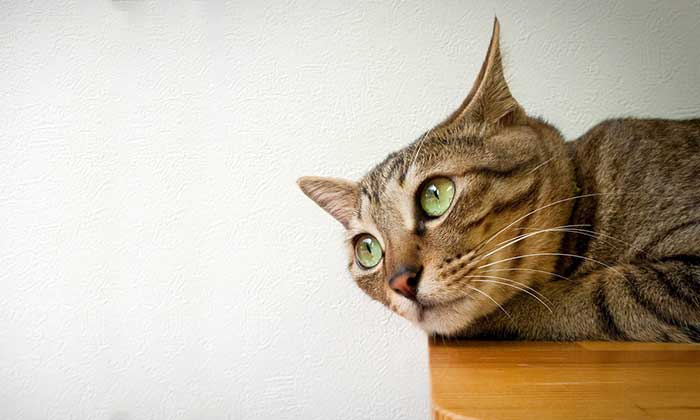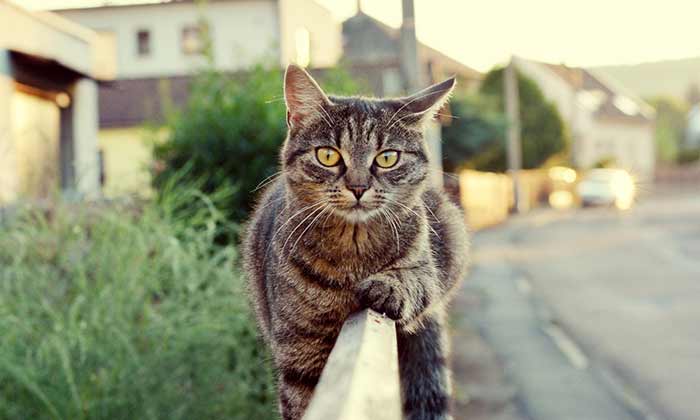Cat Whiskers, Head and Mouth: Understanding Your Cat’s Body Language
Just like a cat’s ears, cat whiskers are incredibly versatile elements of a cat and can be very expressive of a cat’s feelings, mood and behavior. These whiskers cover a cat’s entire face. There are a dozen or so large long whiskers on each side of every cat’s snout, along with several much smaller whiskers above the eyes, on the chin and sometimes along the back of the lower front legs of a cat.
These cat whiskers are all situated very deep in the skin of a cat, which means they are much more sensitive than normal fur hairs. Cat whiskers are designed to feel every small movement or directional change in the air around a cat so that they have a better awareness of their environments. Because whiskers are so sensitive, moving them can end up quite painful – awkward positioning of food bowls, for example, can force a whisker back in an uncomfortable way.
Cat Whiskers Explained
Whiskers have many roles and purposes in the life and protection of a cat, particularly to indicate the feeling or mood of a cat, but also for a range of other things.

Cat whiskers correspond to the width of a cat
Size Matters
First, cat whiskers tell a cat whether it can fit through a particular hole. The whiskers correspond to the width of a cat – if the whiskers can fit through a hole, your cat can be sure that the rest of its body will fit!
All Cats are Grey in the Dark
Second, cat whiskers improve the way in which cats see things in the dark. Sensitive whiskers help the cat determine changes in the air around them, to help them determine the size and position of objects around them or to aid the finding of a particular prey roaming around.
Body Language
And of course, as a third, whiskers act as a key element of the body language of a cat. You can learn to read these signs if you memorize the positions of the whiskers and practice reading these positions in conjunction with the overall body language and mood of your cat.
How to Understand Cat Whiskers
Here’s a look at how to analyze your cat’s whiskers:
Normal / neutral / relaxed / friendly: Cat whiskers that are straight and being held and the sides of your cat’s face indicate that your cat is happy, content and comfortable in its surroundings and with the people around it.
Interested / excited / alert: When your cat’s whiskers move forward and extend outwards, this is a sign that your cat is interested in something. The whiskers move in front of the cat’s muzzle which will cause the cat’s cheek muscles to extend and get bigger. This movement is likely to happen when your cat is playing, chasing after prey, or being aggressive with another cat, object or person.
Fearful / timid / shy: Similarly with flattened down ears, flattened down whiskers at the sides of a cat’s face indicated that a cat is scared or shy. It aims to make a cat look smaller and thus less likely to be a target of any upcoming attack from another aggressive cat or another danger. Your cat wants to avoid appearing threatening in situations like this.
Cat Mouth
Interpreting the mouth of a cat rests of noticing different signs – although this cat feature is much simpler to comprehend. It is very easy for anyone to understand that a cat hissing or displaying its teeth mean that that cat is very upset, angry or threatened. Similarly, it is easy to see that a big yawn from a cat is a sign of a happy and comfortable cat.
Another mouth behavior of cats is known as flehmening – this refers to when a cat smells or sniffs something while keeping its mouth open, to get a better smell of the offending object! To an untrained eye, this movement can look like a cat is grimacing and upset. However, be sure that there is nothing to worry about if your cat acts like this!

Interpreting the mouth of a cat rests of noticing different signs
It is particularly cute when cats exhibit the next mouth behavior. Some cats let their tongue hang out while going about their business, making them look adorable if a little ridiculous! This suggests that the cat is relaxed or perhaps interested in something they have just seen. Licking their lips, on the other hand, indicates that your cat is waiting for something or is anxious for some reason. In these cases, it can be helpful to examine your cat’s immediate surrounding to work out what might be bothering them.
Other feelings that can be indicated by a cat’s mouth include disgust or upset – this is clear when a cat opens its mouth a little and wrinkles up its nose. A cat can also be embarrassed, evident when a cat draws back its lips with no corresponding nose movement and a moving head. This tells other cats to leave it alone for a while.
A more common behavior involves licking you as the owner and other people and cats in your cat’s life. This shows that your cat is happy and feels safe around you, and has warm positive feelings towards you and your home. Cats groom each other by licking each other and are prone to groom those they are happy to be around and feel affection for. The same sort of feeling is indicated when your cat sniffs you. Your cat wants to check that you are you, checking for your unique scent before showering you with affection!
Cats can be known to hiss or snarl with their mouth open, indicating that they feel threatened and want to appear aggressive and defensive.
Whenever your cat grimaces or bares its teeth, sometimes accompanied by a distant stare, this can simply mean that she is thinking about the smells she detects in the air, rather than seeking to appear aggressive.
Cat Head
The cat’s head also tells a lot about their mood and feelings. You can tell that your cat is feeling strong and proud when they are holding their head high up in the air. Conversely, cats drop their heads when they are scared or threatened. A sideways feline head indicates that a cat is not interested in whatever is going on, or that it is communicating that it is not a threat to those around it.
When you interact with your cat and stroke them, they are likely to move their head in response, often exposing the part of their head or neck that they want to be stroked more. This part of the cat’s neck is where their pheromones are stored. Thus by petting a cat here, their pheromones are displaced onto your hands and clothes – your cat will be effectively marking their territory! Cat pheromones can also be found in their cheeks and along their sides.
 By rubbing up against you and the furniture, cats are constantly placing their scent all over their environment. You should interpret this behavior as a sign that your cat is happy and content with you and feels safe in their home. Similarly, this is expressed when a cat raises their rear end while being petted. Your cat is hoping that you will smell them when they do this – there are even more pheromones in the anal glands at the back of a cat. We just appear standoffish to our cats when we obviously refuse to do this and does not harm the bond between us and our feline friends.
By rubbing up against you and the furniture, cats are constantly placing their scent all over their environment. You should interpret this behavior as a sign that your cat is happy and content with you and feels safe in their home. Similarly, this is expressed when a cat raises their rear end while being petted. Your cat is hoping that you will smell them when they do this – there are even more pheromones in the anal glands at the back of a cat. We just appear standoffish to our cats when we obviously refuse to do this and does not harm the bond between us and our feline friends.
Head butting is another behavior that indicates friendship. Cats do this and touch noses, with other cats often when in the same house. Cats may also do this to so when they feel warm and bonded with you. Head rubbing between cats is a similar behavior that we can think of as the feline equivalent of a human handshake. Again, if your cat does this to you, it means that your cat wants to say a friendly hello. If this is accompanied by your cat rubbing its wet nose against you, like a kiss, is another indication that your cat has very warm loving feelings towards you.
A cat’s head also tells us when a cat is feeling angry. A low head with very focused and assertive eyes demonstrates that the cat is aggressive. Your cat might move its head, but its eyes will never leave its target.
When a cat wants to defend and protect itself, it will often hold its head sideways and avoid directly looking at the source of the threat – before running away! Cats will sometimes hiss or spit if threatened but are likely to look for a quick escape rather than risk a real fight.
As with all other body language signs and messages, it is important to understand the overall mood of your cat and to take in every one of the signs being displayed by your cat.
I am very keen to hear your cat stories – if you notice your cat is particularly expressive through their head, mouth or whiskers, please do let me know by sharing your stories in the comments!











